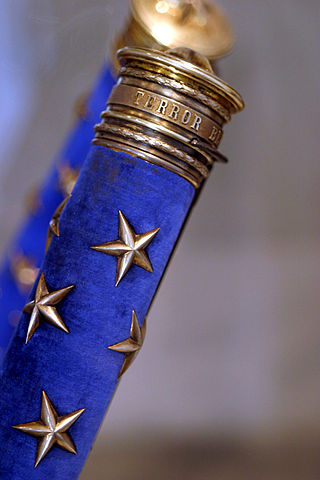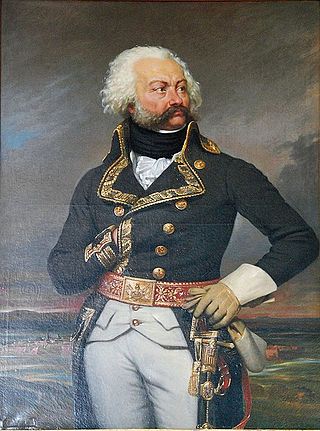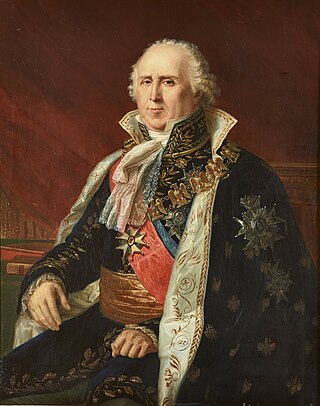
The Prix de Rome or Grand Prix de Rome was a French scholarship for arts students, initially for painters and sculptors, that was established in 1663 during the reign of Louis XIV of France. Winners were awarded a bursary that allowed them to stay in Rome for three to five years at the expense of the state. The prize was extended to architecture in 1720, music in 1803 and engraving in 1804. The prestigious award was abolished in 1968 by André Malraux, then Minister of Culture, following the May 68 riots that called for cultural change.

Marshal of France is a French military distinction, rather than a military rank, that is awarded to generals for exceptional achievements. The title has been awarded since 1185, though briefly abolished (1793–1804) and for a period dormant (1870–1916). It was one of the Great Officers of the Crown of France during the Ancien Régime and Bourbon Restoration, and one of the Grand Dignitaries of the Empire during the First French Empire.

Adam Philippe, Comte de Custine was a French general. As a young officer in the French Royal Army, he served in the Seven Years' War. In the American Revolutionary War he joined Rochambeau's Expédition Particulière supporting the American colonists. Following the successful Virginia campaign and the Battle of Yorktown, he returned to France and rejoined his unit in the Royal Army.

Charles-François Lebrun, 1st duc de Plaisance was a French statesman who served as Third Consul of the French Republic and was later created Arch-Treasurer by Napoleon I.
The Hébertists, or Exaggerators, were a radical revolutionary political group associated with the populist journalist Jacques Hébert, a member of the Cordeliers club. They came to power during the Reign of Terror and played a significant role in the French Revolution.

Marie-Jean Hérault de Séchelles was a French judge, freemason and politician who took part in the French Revolution.
The Commission des Sciences et des Arts was a French scientific and artistic institute. Established on 16 March 1798, it consisted of 167 members, of which all but 16 joined Napoleon Bonaparte's campaign in Egypt and produced the Description de l'Égypte. More than half were engineers and technicians, including 21 mathematicians, 3 astronomers, 17 civil engineers, 13 naturalists and mining engineers, geographers, 3 gunpowder engineers, 4 architects, 8 artists, 10 mechanical artists, 1 sculptor, 15 interpreters, 10 men of letters, 22 printers in Latin, Greek and Arabic characters. Bonaparte organised his scientific 'corps' like an army, dividing its members into 5 categories and assigning to each member a military rank and a defined military role beyond his scientific function.
The Army of the Moselle was a French Revolutionary Army from 1791 through 1795. It was first known as the Army of the Centre and it fought at Valmy. In October 1792 it was renamed and subsequently fought at Trier, First Arlon, Biesingen, Kaiserslautern, Froeschwiller and Second Wissembourg. In the spring of 1794 the left wing was detached and fought at Second Arlon, Lambusart and Fleurus before being absorbed by the Army of Sambre-et-Meuse. In late 1794, the army captured Trier and initiated the Siege of Luxembourg. During the siege, the army was discontinued and its divisions were assigned to other armies.

Joseph-Henri baron de Jessé (1755–1794) was a French nobleman and government official, who served as president of the French National Constituent Assembly from 30 August 1790 to 10 September 1790.

The Parlement of Aix-en-Provence was the provincial parlement of Provence from 1501 to 1790. It was headquartered in Aix-en-Provence, which served as the de facto capital of Provence.

The Holy September Martyrs, also referred to as the Blessed Martyrs of Carmes, is the term sometimes used for 191 Catholics killed at the Carmes Prison in Paris in the September Massacres of 1792 during the French Revolution.
The Rochefort martyrs were 64 of the 829 Catholic clergymen deported in the course of persecutions of opposition clergymen after the French Revolution. They were held in prison ships off Rochefort in inhumane conditions, and at least 505 of them died. The Rochefort martyrs were beatified by Pope John Paul II in 1995.
The term "Red Priests" or "Philosopher Priests" is a modern historiographical term that refers to Catholic priests who, to varying degrees, supported the French Revolution (1789-1799). The term "Red Priests" was coined in 1901 by Gilbert Brégail and later adopted by Edmond Campagnac. However, it is anachronistic because the color red, associated with socialist movements since 1848, did not signify supporters of the French Revolution, who were referred to as "Blues" during the civil wars of 1793–1799, in contrast to the royalist "Whites". Hence, a recent historian suggested using the term "Philosopher Priests" to describe this group, a term used at the time to refer to these priests.

The Colbert family is a surviving family of the French nobility, originally from Reims, Marne. Descended from merchants and bankers established in Reims and Troyes in the 16th century, the family formed several branches which successively acceded to the nobility during the 17th century. The Troyes line, a cadet branch which is the only branch surviving today, was the first to be ennobled in 1603 by the purchase of a position as Counselor Secretary to the King.








